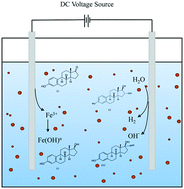Removal of estrogenic compounds via iron electrocoagulation: impact of water quality and assessment of removal mechanisms†
Abstract
Estrogenic compounds pose a range of ecological and public health risks. They are not readily removed via conventional drinking water treatment and are thus listed on the EPA Contaminant Candidate List. Electrocoagulation is an alternative drinking water treatment process that generates coagulations in situ and offers potential for removal of organic micropollutants via redox reactions and anodic oxidation. An iron electrocoagulation bench-scale batch reactor was used to investigate the influence of water quality parameters and removal mechanism of four estrogenic compounds, estrone (E1), 17β-estradiol (E2), estriol (E3), and 17α-ethynylestradiol (EE2). High pH (pH 9.5) yielded greater removal than neutral and low pH (pH = 5.5). Turbidity and dissolved organic carbon had minimal impact on removal of estrogenic compounds. Removal mechanisms were elucidated via a series of experiments to identify the role of adsorption and oxidation; direct anodic oxidation at the anode surface was likely the primary removal mechanism. Oxidation, including at the anode surface and from reactive oxygen species, accounted for an estimated 55% to 68% of removal. Using the oxidant scavenger's tert-butyl alcohol and methanol it was determined that reactive oxygen species, possibly hydroxyl radicals and ferryl iron, likely contributed to ≤22% of estrogen removal. Examination of transformation products confirmed E1 was a transformation product of EE2, and E3 was a transformation product of E2. Removal due to adsorption to electrocoagulation iron flocs was ≤5% for E1, E2, and E3, and accounted for 22% of EE2 removal. Conventional jar tests revealed that estrogen removal due to enmeshment in flocs accounted for <9% removal of E1, E2, and E3 and approximately 30% for EE2 with ferric sulfate and <24% for E1, E2, and E3 and approximately 42% for EE2 with ferrous sulfate. Electric energy per order was much larger for EC compared to other oxidation technologies reported in the literature.



 Please wait while we load your content...
Please wait while we load your content...
